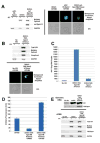Detection of human immunodeficiency virus RNAs in living cells using Spinach RNA aptamers
- PMID: 27914932
- PMCID: PMC5195857
- DOI: 10.1016/j.virusres.2016.11.031
Detection of human immunodeficiency virus RNAs in living cells using Spinach RNA aptamers
Abstract
Many techniques currently used to measure HIV RNA production in cells suffer from limitations that include high background signal or the potential to destroy cellular context. Fluorophore-binding RNA aptamers offer the potential for visualizing RNAs directly in living cells with minimal cellular perturbation. We inserted a sequence encoding a fluorophore-binding RNA aptamer, known as Spinach, into the HIV genome such that predicted RNA secondary structures in both Spinach and HIV were preserved. Chimeric HIV-Spinach RNAs were functionally validated in vitro by testing their ability to enhance the fluorescence of a conditional fluorophore (DFHBI), which specifically binds Spinach. Fluorescence microscopy and PCR were used to verify expression of HIV-Spinach RNAs in human cells. HIV-1 gag RNA production and fluorescence were measured by qPCR and fluorometry, respectively. HIV-Spinach RNAs were fluorometrically detectable in vitro and were transcribed in human cell lines and primary cells, with both spliced and unspliced species detected by PCR. HIV-Spinach RNAs were visible by fluorescence microscopy in living cells, although signal was reproducibly weak. Cells expressing HIV-Spinach RNAs were capable of producing fluorometrically detectable virions, although detection of single viral particles was not possible. In summary, we have investigated a novel method for detecting HIV RNAs in living cells using the Spinach RNA aptamer. Despite the limitations of the present aptamer/fluorophore combination, this is the first application of this technology to an infectious disease and provides a foundation for future research into improved methods for studying HIV expression.
Keywords: Aptamers; HIV-RNA; Spinach.
Copyright © 2016 Elsevier B.V. All rights reserved.
Figures


References
-
- Bertrand E, Chartrand P, Schaefer M, Shenoy SM, Singer RH, Long RM. Localization of ASH1 mRNA particles in living yeast. Molecular cell. 1998;2(4):437–445. - PubMed
-
- Chizzolini F, Forlin M, Cecchi D, Mansy SS. Gene position more strongly influences cell-free protein expression from operons than T7 transcriptional promoter strength. ACS synthetic biology. 2014;3(6):363–371. - PubMed
Publication types
MeSH terms
Substances
Grants and funding
LinkOut - more resources
Full Text Sources
Other Literature Sources

